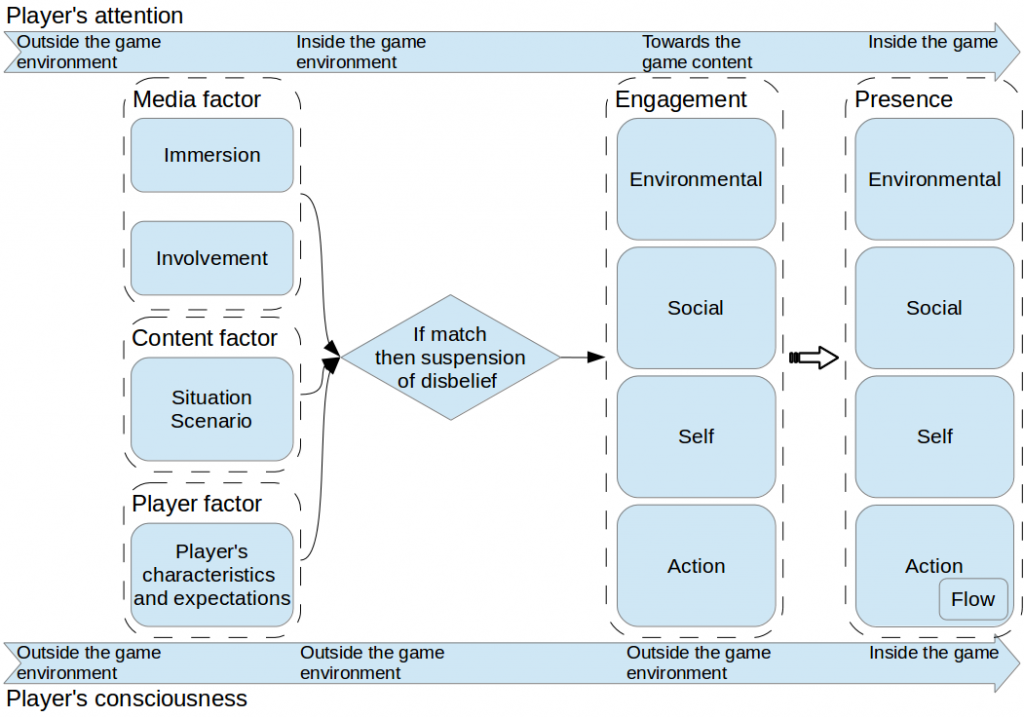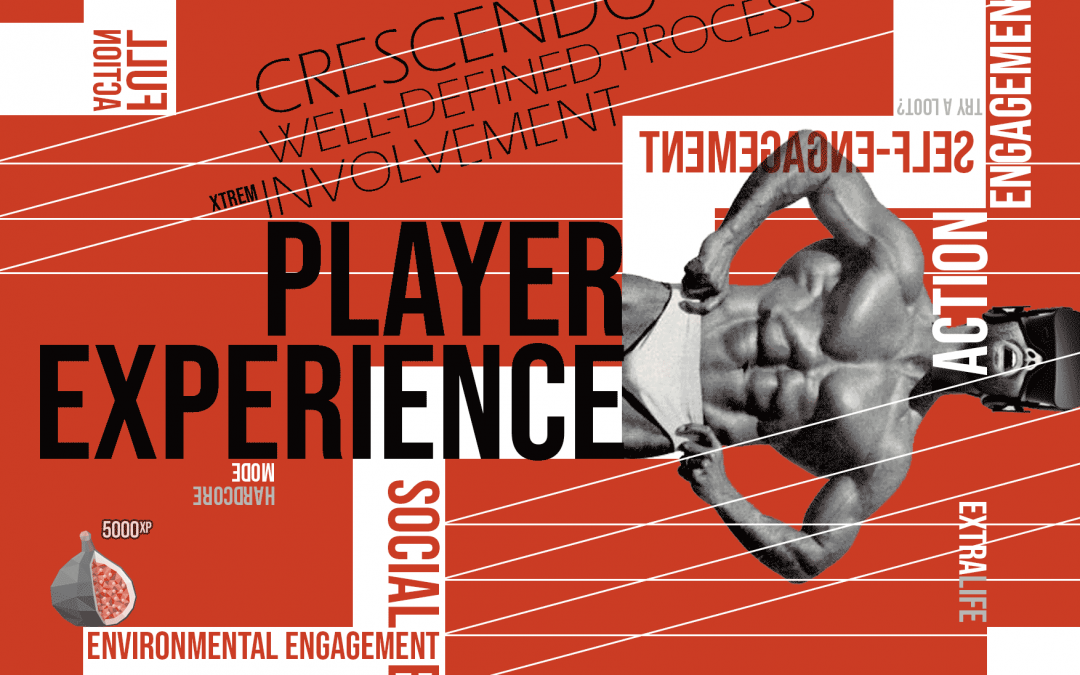5th and final article in a series aimed at defining, delimiting and organizing the concepts of attention, immersion, involvement, engagement, flow and presence. This 5th article organizes the concepts that form the player experience.
The other articles in the series:
- Article 1 presenting the context of this research
- Article 2 dealing with attention and immersion
- Article 3 dealing with implication and engagement
- Article 4 dealing with presence and flow
Preamble
This series of 5 articles includes part of the research article entitled “Defining Engagement and Characterizing Engaged-Behaviors in Digital Gaming” that I published in the journal Simulation & Gaming (Bouvier et al., 2014). You will find the reference at the end of the article.
Please note that while these articles have a video game dimension (playful or serious), the suggestions are also applicable to other technological and social activities such as virtual reality.
Positioning the concepts
Previously…
The work done on the terminology in the previous 4 articles made it possible to define and delimit the scope of the concepts commonly associated with the player experience: attention, immersion, involvement, engagement, presence and flow. Restricting these concepts to clearly-defined action perimeters makes it possible to organize them. With the usual definitions and understandings, the concepts had the unfortunate tendency to overlap…
Let us recall these definitions:
Attention is the set of processes that allow and guide the selection of information (Roda et Thomas, 2006).
Immersion is the objective and measurable description of the means and methods used to ensure the perception, understanding and ultimately the appropriation of the virtual environment (Bouvier, 2009).
Involvement is the willingness to exchange information with the system through interaction devices (Bouvier et al., 2014).
Engagement is the willingness to have emotions, affect and thoughts directed towards and aroused by the media activity in order to achieve a specific objective (Bouvier et al., 2014).
Presence is the authentic feeling of existing in a world other than the physical world in which the body is (Bouvier, 2009).
Flow is the optimal experience, a mental state of intense concentration in which a person is completely absorbed in her/his task and situation (Csikszentmihalyi, 1991).
Organizing the concepts
With this clarification work done, it is now possible to organize these concepts. I will situate them on a scale according to the shifting of the player’s attention and consciousness from the real world to the virtual world. Each concept corresponds to a specific location of attention and consciousness.
The figure below illustrates this organization. Here, the player’s attention and awareness can be seen as 2 points or sliders in the player experience. I won’t go back to the definition of attention. For consciousness I use Damasio and Meyer’s definition (2008), which describes consciousness as « a momentary creation of neural patterns that describe a relation between the organism, on the one hand, and an object or event, on the other ». It’s this idea of a relationship that is of interest here. A relationship between the player on the one hand and the real or virtual world on the other hand.

At the start of the process, on the left-hand side of Figure 1, the player’s attention and consciousness are focused on the real environment. Here we will find the 3 types of factors in a mediated activity:
- factors related to the form of the mediated activity (e.g. the technology used); here we have the concepts of immersion and involvement;
- content-related factors, i.e. the described situation, the proposed plot, the objectives, the rules for achieving them, etc.;
- human factors that refer to the player’s characteristics, such as age, gender, psychology, cognitive or physical abilities, knowledge and skills, as well as previous experiences, current mood, motivation and needs.
The goal of the factors related to content and form is to draw the player’s attention from the real environment to the virtual environment (the game environment), and then to retain it in the virtual environment. Thus, the virtual environment and interaction tools (e.g. joystick, mouse, or HTC Vive controller) become the mixed-reference environment for the player.
If the factors related to immersion, involvement and content satisfy the player’s perceptual, interactive and intellectual expectations, then the player is ready to suspend his disbelief (Coleridge, 1969) in order to engage in the activity (see article 3). In other words, the player agrees take part in the activity in a way that makes it possible to experience it more intensely (his critical mind is switched off in order to overlook the limits and technical or narrative defects of the activity). Experience more intensely means to feel the emotions evoked by the activity more intensely.
Up to the stage before the suspension of disbelief, there is no experience, just objective properties and characteristics. It’s only from the point where suspension of disbelief takes place that the player enters into experience, and therefore into subjectivity.
When a player is engaged, her/his attention is focused on the activity’s content (what s/he must do or can do during the activity). Depending on the content and the player’s expectations, the player may adopt one or another type of engaged behaviors (Environmental, Social, Self, Action in the diagram above).
I won’t go into detail about these 4 types of engaged behaviors at this point, because they will be the subject of a future article. Here is a brief overview:
- Environmental engagement is directed towards the environment or the world described in the game (e.g when a player particularly appreciates the aesthetics of a game or seeks to discover an entire map);
- Social engagement refers to the possible social interactions within the game (for example the pleasure of playing with friends or meeting new players);
- Self-engagement refers to the connection between the player and her/his character (e.g. the pleasure of customizing her/his avatar);
- Action engagement is directed towards the actions taken in order to achieve an objective (to pass level, to achieve challenges, etc.).
Engagement doesn’t require the player to lose mental contact with the real world, so an engaged player is always aware of his environment and the passing of time. The player’s consciousness is therefore always present in the real environment.
On the other hand, presence and flow are experiences that require the shifting of consciousness from the real environment to the game or activity’s virtual environment. This is why presence comes, if it comes at all, after engagement. Indeed, although all activities can become engaging, only a very limited number of them can create a sense of presence. Tetris or Candy Crush can be very engaging for some players but will not create a sense of presence. Flow is part of the Action component of the sense of presence because this state is focused on the actions that are taken in order to succeed when faced with a challenge.
This work of redefinition and theoretical positioning is particularly useful when dealing with phenomena that are abstract and difficult to measure, such as engagement or presence. It makes the subject easier to discuss, to be clear about the objectives, or what is being analyzed. It also enables you to validate comparisons between different methods and approaches addressing a concept.
Player experience? User experience? Operator experience?
The QuEJAnT project aimed to analyze the engagement of learners or players in serious or entertaining games. Do you recognize your own experience as a player in the process described above?
The definitions and process outlined here are sufficiently generic (as they focus on the phenomena generated and not on their underlying factors) to be applied to all mediated activities, not just to games. These articles could have been written about the user or operator experience during virtual reality training, right? What do you think?
Bibliography
Bouvier, P., Lavoué, E., & Sehaba, K. (2014). Defining Engagement and Characterizing Engaged-Behaviors in Digital Gaming. Simulation & Gaming, 45, 4-5, 491-507. PDF
Bouvier, P. La présence en réalité virtuelle, une approche centrée utilisateur, Thèse de doctorat, Université Paris-Est, France, 2009. PDF
Coleridge, S. T. (1969). The collected works of Samuel Taylor Coleridge. London, England: Princeton University Press.
Csikszentmihalyi, M. (1991). Flow: The psychology of optimal experience. New York, NY: Harper Perennial.
Damasio, A., & Meyer, K. (2008). Consciousness: An overview of the phenomenon and of its possible neural basis. In S. Laureys & G. Tononi (Eds.), The neurology of consciousness (pp 3-14). London, England: Elsevier.
Roda, C., & Thomas, J. (2006). Attention aware systems: Theories, applications and research agenda. Computers in Human Behavior, 22, 557-587.
Graduated with a PhD in Computer Science in 2009, I have been immersed in virtual reality for more than 15 years. Passionate about the user experience, I like to explore new technologies and new uses to develop with my colleagues in production and marketing, vivid and effective products for more engaging experiences.




